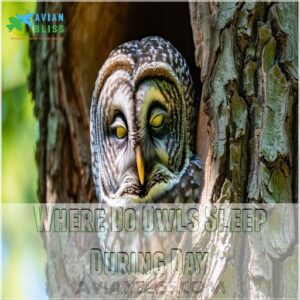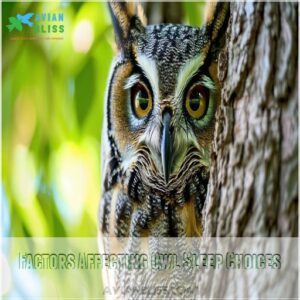This site is supported by our readers. We may earn a commission, at no cost to you, if you purchase through links.

Owls catch some Z’s in cool, hidden spots like high tree branches, hollows, or dense foliage.
Some even roost on rock ledges or in the cozy nooks of buildings.
Their goal? Stay safe, unnoticed, and ready for night-time adventures.
With their impressive camouflage, owls blend seamlessly into their surroundings, making them masters of the hide-and-seek game.
Next time you stroll past a quiet wooded area, keep an eye out—there could be an owl snoozing just above your head, poised for nighttime action.
Table Of Contents
- Key Takeaways
- Where Do Owls Sleep During Day
- Where Do Owls Commonly Sleep
- Owl Sleep Patterns and Adaptations
- Types of Owl Sleep Locations
- Factors Affecting Owl Sleep Choices
- Owl Sleep Positions and Postures
- Unique Roosting Behaviors of Owl Species
- How Long Do Owls Sleep During Day
- Owl Sleep Habits and Pre-Sleep Rituals
- Evolutionary Significance of Owl Sleep
- Frequently Asked Questions (FAQs)
- Do owls sleep in the nest?
- Where do owls sleep?
- How much sleep do owls need?
- Why do owls sleep?
- Do snowy owls sleep at night?
- Are sleeping owls easy to find?
- Where do owls go during the day?
- How long do owls stay in one place?
- Do owls sleep during the day?
- What does it mean if an owl is out during the day?
- How do owls protect themselves while sleeping?
- Do owls sleep more during certain seasons?
- What noises could disturb an owls sleep?
- How does weather affect owl sleep locations?
- Are young owls sleep patterns different from adults?
- Conclusion
Key Takeaways
- You’ll find owls sleeping in trees, tree hollows, and even abandoned buildings during the day to stay concealed from predators.
- They cleverly use their camouflage and choose secluded spots to ensure safety and energy conservation for nighttime hunting.
- Owls sleep with one eye open, using half their brain to stay alert to potential threats while resting.
- Their sleep needs about 12 hours a day, and they are adaptable, using different locations and strategies depending on the environment and season.
Where Do Owls Sleep During Day
Owls have some quirky habits regarding where they catch their daytime Z’s.
They prefer peace and quiet, staying high and dry by resting in trees or secluded corners, often choosing caves and rock crevices that provide essential protection.
Think of them as introverted sleepers, avoiding the busyness of the world to get their much-needed rest.
Owls’ incredible sleep adaptations let them nap during the day: one eye peeks open while the other snoozes.
This half-awake magic keeps them aware of any unwelcome guests.
Their sleep cycle is a delicate dance, helping them conserve energy for nighttime antics.
If you’re ever looking for an owl during the day, imagine a secretive Airbnb guest tucked away in the natural world’s lofted branches.
Where Do Owls Commonly Sleep
When the sun’s up, these stealthy night hunters need their beauty sleep in peace. You’re probably wondering where they catch their Z’s. Here’s what owl sleep researchers have figured out about their snoozing habits.
- Trees and Branches: A favorite napping spot involves high, hidden branches where they can blend into the foliage. Imagine a leafy blanket shielding them from prying eyes.
- Tree Hollows or Crevices: These provide a cozy, sheltered nook—like nature’s own little owl apartment.
- Man-made Structures: Think deserted barns or dilapidated buildings, offering shelter and safety that’s hard to pass up.
Some birds like Carolina wrens seek out corners for protection, which can offer camouflage and concealment from predators. Wherever they roost, it’s all about owl nesting preferences for sleep safety and freedom from predators.
Owl Sleep Patterns and Adaptations
You’ll find that owls have fascinating sleep patterns and adaptations, allowing them to rest securely during the day.
These birds manage to sleep with one eye open, literally, thanks to their ability to keep half of their brain alert, ensuring they’re ready to respond to any threat.
Nocturnal Behavior and Sleep
Most owls are nocturnal, meaning they’re active at night and sleep during the day.
Their sleep isn’t like ours; owl sleep cycles include periods of REM and non-REM sleep, but they can also doze off quickly, even with half their brain awake—a handy adaptation for staying alert to danger.
Owl sleep positions usually involve perching upright, with their zygodactyl feet and hooked talons providing a strong grip, thanks to their specialized toe pads, conserving energy for their nighttime hunts.
Research into owl sleep is ongoing, revealing fascinating sleep adaptations.
Diurnal Behavior and Sleep
Just as some owls embrace the night, diurnal owls flip your expectations, thriving in daylight.
With bright yellow eyes attuned for daytime foraging, these owls navigate sunlit trails while cleverly dodging predators.
Their eye structure, uniquely adapted for clarity in full light, supports their sun-induced sleep cycles, allowing them to rest under the sun’s watchful eye.
Crepuscular Behavior and Sleep
Crepuscular owls, like Snowy Owls and Burrowing Owls, play it smart by napping at dusk and dawn, when others aren’t paying attention, and often adapt their daytime habits to suit their specific needs, which can be influenced by understanding owl daytime habits.
This twilight hunting strategy helps them dodge predation risk and conserve energy.
Seasonal variations can affect their rest spots, but typically, they snag quiet branches or snug spots for catching their critical winks.
It’s nature’s balancing act!
Types of Owl Sleep Locations
When you’re uncovering where owls sleep during the day, you’ll find their choices as varied as their personalities.
From high tree branches and hidden caves to the nooks of human-made structures, each location offers a perfect blend of safety and camouflage.
Trees and Branches as Sleep Locations
Perched high on branches, owls cleverly find their sleeping spots, often hidden among leafy trees.
They select branch heights that help with predator avoidance while ensuring stability with just the right branch diameter.
For a more comfortable resting experience, owners can purchase owl-friendly products like nesting boxes or perches from Owl Sleeping Essentials.
Owls might reuse old nests, tucked securely in various tree species.
This crafty choice of sleeping locations showcases their keen instinct for safety and comfort.
Caves and Rock Crevices as Sleep Locations
Ever found yourself wondering where owls catch their daytime Z’s?
Many species, like the Lesser Sooty Owl, find comfort in caves and rock crevices.
These snug spots offer crevice protection and rock shelter, with cave acoustics providing natural vigilance.
Owls blend with crevice camouflage, staying hidden from predators while enjoying a peaceful nap in nature’s secret nooks.
Human-Made Structures as Sleep Locations
While owls find nature’s nooks, they also snugly nestle in our human-made structures.
Imagine stumbling upon an owl quietly snoozing in an abandoned barn or an old chimney.
These urban owl roosts provide vital safety from predators and harsh weather.
It’s a demonstration of their adaptability, adjusting their sleep spots in cities where human impact reshapes the landscape.
Factors Affecting Owl Sleep Choices
Several factors influence where owls choose to rest during the day.
Camouflage is essential for owls to avoid predators.
They also need to conserve energy to maximize their hunting success at night.
Safety and Protection From Predators
Owls need to catch some z’s safely, socking away from predators’ prying eyes.
Picture them snoozing on a high tree branch or nestled in a secluded nook—they’re savvy about picking prime real estate!
This knack for choosing secure spots lets them snooze peacefully and gear up for their nightly adventures.
Think of it as a perfectly chosen hiding spot against those roosting hazards.
Camouflage and Concealment Abilities
In the realm of camouflage and concealment, owls are the masters of disguise.
Imagine spotting one in broad daylight—tricky, right?
Their feather patterns work like a natural cloak, blending seamlessly with their surroundings.
Here are three reasons why:
- Owl feather patterns mimic bark or foliage.
- Seasonal adaptations adjust their looks.
- Nocturnal camouflage keeps them hidden from day threats.
Energy Conservation and Hunting Strategies
Imagine you’re an owl, balancing the fine line between dreamland and the hunt.
It’s all about energy efficiency.
With your camouflage, you effortlessly blend in while sleeping, conserving every drop of energy.
When sleeping face down, a behavior common in owls sleeping face down, you’re able to protect your sensitive eyes from harsh sunlight and maintain a low profile.
Then, when dusk settles, you’re awake, bringing honed hunting tactics into play.
Your prey selection? Excellent, making sure the sleep-hunt balance keeps you flourishing.
Owl Sleep Positions and Postures
Owls have unique sleep positions that keep them balanced and ready for quick action.
You’ll often find them perched upright on branches, thanks to their strong neck muscles, which might make you wonder if they ever dream of being acrobats.
Perched Sleep Positions and Advantages
Picture an owl perched high on a branch, enjoying the stability.
This sleep posture offers three key advantages:
- Branch stability: It holds the owl secure while they rest.
- Head orientation: Allows them to swivel and stay alert.
- Feather insulation: Provides warmth and helps with predator protection.
These adaptations help maintain owl sleep posture effectively.
Ground Sleep Positions and Disadvantages
Sleeping on the ground isn’t a hoot for owls.
It makes them easy targets for predators, exposing them to all sorts of risks.
They prefer safer perches, where they can keep an eye out.
Let’s peek at ground vs. perched sleep:
| Position | Safety | Visibility |
|---|---|---|
| Ground | Low | Limited |
| Perched | High | Excellent |
| Nest | Moderate | Fair |
Branch Sleep Positions and Considerations
Owls often choose branches as daytime sleeping spots.
Branch height is key; higher branches offer better predator avoidance.
Perch stability matters too—a wobbly branch is a recipe for disaster! To maintain balance and stability, owls rely on their balance-sensing organs.
Consider these factors:
- Weather protection: A sheltered branch keeps them dry.
- Camouflage impact: Branch color helps them blend in.
- Predator avoidance: High, hidden branches are safer.
Unique Roosting Behaviors of Owl Species
You might be surprised by how diverse owl roosting habits can be, ranging from the treetop perches of small owl species to the hidden burrows of burrowing owls.
Larger owls prefer more secluded spots, utilizing their hefty size to secure safe, elevated roosts.
Small Owl Species and Roosting Habits
Small owl species often choose snug, cavity roosting sites, offering safety from prowling predators.
You’ll find them nesting in tree hollows, abandoned woodpecker holes, or even crevices in rocks.
These tiny owl sleep patterns are a dance of survival, relying on camouflage to blend into their environment.
Similar to cardinals that often switch up their roosting spots for safety, roosting behavior differences highlight their knack for picking sheltered, concealed spots, ensuring rest in peace and quiet.
Larger Owl Species and Roosting Preferences
When considering larger owls’ roosting preferences, think of a cozy spot high in a favorite tree species.
These majestic birds often choose roosting heights away from ground predators, showcasing impressive habitat selection.
With their sharp eyes, nest preferences lean toward concealed branches, ensuring predator avoidance.
Larger owls instinctively find spaces that promise safety, making every choice about survival and comfort.
Burrowing Owls and Underground Burrows
Picture Burrowing Owls as nature’s real estate agents, nestled in underground burrows for an extra layer of protection.
They cleverly use and maintain these burrows, originally dug by prairie dogs, to shelter from predators and extreme weather.
These owls exhibit unique social behaviors, often living in small colonies, which helps in efficient prey selection and strategic predator defense.
How Long Do Owls Sleep During Day
Owls typically snooze for around 12 hours a day, catching extended rest periods to conserve energy for their nocturnal activities.
You might find it surprising that they can doze off in mere seconds, keeping half their brain alert to stay aware of their surroundings.
Average Sleep Time for Owls
Owls need about 12 hours of sleep a day, making the most of their naps to recharge.
While studying owl sleep cycles, researchers find these rest periods essential for hunting success.
Imagine trying to function on just a few hours of sleep—you’d be crankier than a cat missing its nap!
- Serene treetop snoozes
- Half-brain vigilance
- Quick recharge naps
- Silent dreamers
- Nature’s power nap masters
Variations in Sleep Duration and Factors
While owls generally sleep around 12 hours, that’s just an average.
Think of it like human sleep—some need more, some less.
Several things change an owl’s sleep time.
Like other birds, owls use unique sleep adaptations, such as unihemispheric slow-wave sleep (USWS) details on USWS and bird sleep, to get rest while staying alert for predators.
| Factor | Impact on Sleep Duration | Example |
|---|---|---|
| Season | Longer in winter, shorter in summer | More daylight hours mean less sleep in summer |
| Age | Young owls sleep more than older, more experienced ones | Chicks need lots of rest to grow |
| Health | Illness can disrupt sleep patterns | A sick owl might sleep more or less than usual |
These variations are completely normal.
Sleep Cycles and Patterns in Owls
After exploring why owls sleep as long as they do, let’s check out their owl-some sleep cycles.
Owls master a delicate balance between quick naps and deep slumbers, even experiencing REM sleep.
Their brain stays half-awake, ever-vigilant for threats.
Seasonal sleep changes guide their rest patterns.
Noise or light can disrupt this delicate sleep dance.
Owl Sleep Habits and Pre-Sleep Rituals
You’ll find that owls are particular about their pre-sleep routines, choosing sleep spots with care to avoid predators.
Whether in captivity or the wild, they stick to quiet areas, proving they’re more selective about naptime than a picky teen looking for the perfect playlist to fall asleep to.
Pre-Sleep Behaviors and Preparation
Before settling in, owls engage in curious pre-flight rituals.
They often perform environmental checks to find the perfect spot, adjusting to sensory changes like light and sounds.
Nest preparation might include fluffing feathers or choosing just the right branch.
Consider it a pre-hunt routine—getting comfy before the night’s quest makes sure they’re ready to swoop silently into the night.
Sleep Locations and Selection Criteria
Choosing a cozy roost isn’t just guesswork for owls.
These birds pick spots with care, balancing habitat and safety.
Ever noticed how they nestle in treetops or cliff crevices?
That’s their way of dodging nosy predators.
Seasonal changes and climate influences also steer their choices, ensuring comfort like picking a perfect hideaway escape, adapting wisely to the elements.
Sleep in Captivity Vs. Wild Environments
In the wild, owls choose sleep spots based on safety, camouflage, and energy needs.
Captivity, though, changes this dance.
An owl’s enclosure impacts sleep by altering stress levels and removing natural habitat influences.
Captive care considers these shifts, aiming to mimic natural routines.
Sleep becomes a balance between familiar comforts and the innate call of their wild instincts.
Evolutionary Significance of Owl Sleep
When you think about owl sleep, consider how their unique patterns have evolved to boost their hunting success and survival.
Owls’ ability to stay alert even while resting is a clever trick from nature, much like keeping one eye on your snacks so your sibling doesn’t steal them.
Adaptations for Survival and Hunting Success
Owls’ survival hinges on their incredible adaptations.
Their success is a strong indicator of evolution’s power.
Just like other birds, owls require 10-12 hours of sleep daily, which is very important for their overall health, mood, and strengthening a bird’s sleep.
Think about these key features:
- Silent flight: Specialized feathers let them sneak up on prey.
- Camouflage: Their plumage blends seamlessly with their surroundings.
- Nocturnal vision: Large eyes and rod cells let them see in the dark.
- Exceptional hearing: They pinpoint prey even in total darkness.
These adaptations make them excellent hunters, ensuring their continued success.
Sleep Patterns and Evolutionary Advantages
Ever wonder how owls pull off their stealthy antics?
It’s like they’ve got sleep down to a science, even using a secure daytime roost for rest equipped with owlet care products.
Their half-asleep brains are wired to spot danger, cleverly weaving sleep and awareness.
Such adaptations guarantee exceptional camouflage techniques and silent flight.
This perfect harmony of rest and alertness boosts their hunting strategies, linking sleep directly to survival.
Frequently Asked Questions (FAQs)
Do owls sleep in the nest?
Owls often sleep in nests, especially during the breeding season.
Females might stay with the owlets, while males hunt.
Outside breeding times, adults sleep in trees, hollows, or secure spots where they’re masked and safe from predators.
Where do owls sleep?
You’ll find owls snoozing in safe, quiet spots like tree branches, hollows, cliff ledges, and abandoned buildings.
They prize locations far from hustle and bustle, ensuring a serene retreat to conserve energy for nighttime adventures.
How much sleep do owls need?
Most owls need around 12 hours of sleep daily.
They often take short naps, cleverly using only half their brain at a time to stay alert.
This unique sleep style helps them survive in their often-dangerous world.
Why do owls sleep?
Imagine recharging your mental batteries like owls—sleep helps them conserve energy for hunting.
By resting, owls enhance alertness, process information, and maintain peak performance in their nocturnal adventures, ensuring survival in nature’s challenging theater.
Do snowy owls sleep at night?
Snowy owls, known for being crepuscular, primarily hunt during dawn and dusk.
They are adaptable and can be active at any time.
While they rest when necessary, they don’t strictly sleep at night like diurnal creatures.
Are sleeping owls easy to find?
About 70% of owl species are nocturnal, which makes finding them during their daytime naps a bit tricky.
They skillfully hide in tree hollows, cliff ledges, or abandoned buildings, blending seamlessly with their surroundings.
Where do owls go during the day?
Owls perch on trees or find solace in tree hollows, cliff ledges, and even deserted buildings during the day.
They pick these quiet, secure spots to catch some z’s, staying hidden from predators and disturbances.
How long do owls stay in one place?
Ever wondered why that owl barely moves?
They tend to stay in one place for extended periods, commonly several days, especially when they’ve found a safe perch or a reliable hunting ground that meets their needs.
Do owls sleep during the day?
Yes, most owls sleep during the day, taking refuge in quiet, safe spots like trees, cliff ledges, or abandoned buildings.
They conserve energy for nighttime hunting, often napping lightly with only half their brain asleep.
What does it mean if an owl is out during the day?
Daytime owl sightings? Don’t fret! Most owls are nocturnal, so a daytime appearance might mean illness, injury, or perhaps it’s a diurnal species like the Northern Hawk Owl.
How do owls protect themselves while sleeping?
Owls protect themselves while sleeping by choosing safe, secluded spots like tall trees or hidden cliffs.
They sleep with one eye open and one hemisphere of their brain alert, staying vigilant against potential threats while resting.
Do owls sleep more during certain seasons?
Regarding seasonal sleep patterns, you might notice that owls don’t really change their sleep duration, typically needing around 12 hours of sleep per day, regardless of the time of year.
What noises could disturb an owls sleep?
Loud, sudden noises like nearby construction, heavy traffic, or barking dogs can disturb an owl’s sleep.
Consistent, unfamiliar sounds disrupt their rest, as they’re adapted to sleep in quiet, secluded environments for safety and vigilance.
How does weather affect owl sleep locations?
Owls, like other cavity roosters, often seek shelter in tree hollows and nest boxes. Cold, wet weather may push owls to seek sheltered sleep spots like tree hollows or abandoned buildings.
Owls will seek out cooler, shaded areas during hot, sunny days to stay comfortable and maintain their energy levels.
Are young owls sleep patterns different from adults?
Think of young owls as enthusiastic learners.
While adult owls nap lightly and swiftly, owlets indulge in longer, deeper rest to support growth.
Their patterns gradually align with adults as they age and develop.
Conclusion
So, understanding where owls sleep during the day reveals their remarkable adaptations.
Owls, masters of camouflage, cleverly choose concealed locations—high in trees, within hollows, or nestled in rock crevices.
Their daytime slumber is essential for nighttime hunting success.
Finding where owls sleep during the day highlights their impressive survival strategies.
These secretive sleep sites guarantee safety from predators, saving energy for their nocturnal activities.
Observing these hidden havens offers a glimpse into the fascinating lives of these nocturnal birds of prey.














